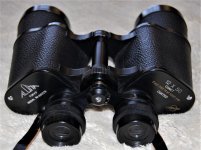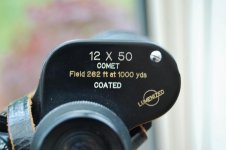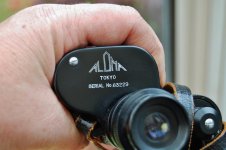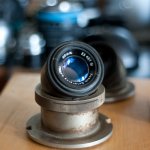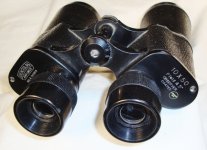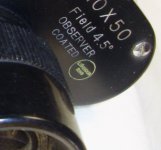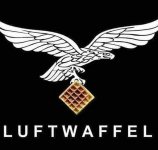-
Welcome to BirdForum, the internet's largest birding community with thousands of members from all over the world. The forums are dedicated to wild birds, birding, binoculars and equipment and all that goes with it.
Please register for an account to take part in the discussions in the forum, post your pictures in the gallery and more.
You are using an out of date browser. It may not display this or other websites correctly.
You should upgrade or use an alternative browser.
You should upgrade or use an alternative browser.
Lumenised? (1 Viewer)
- Thread starter johnbaz
- Start date
More options
Who Replied?WJC
Well-known member
Hi all
I have a Japanes Aloma Comet 12x50 binocular that has 'Lumenised' printed on, Does anyone know what this means with Binoculars as i've never been able to find out!!
Cheers, john :t:
More "special" words geared to selling optics. It's a word used in sales ... not optics.
"Auto-focus" or "triple tested" anyone?
GOOD advertising need not be ACCURATE, or even MEANINGFUL, It has only to be believed and the uninitiated have a proclivity to believe anything they see in print. :cat:
johnbaz
Well-known member
More "special" words geared to selling optics. It's a word used in sales ... not optics.
"Auto-focus" or "triple tested" anyone?
GOOD advertising need not be ACCURATE, or even MEANINGFUL, It has only to be believed and the uninitiated have a proclivity to believe anything they see in print. :cat:
Ahhh!
Thanks WJ, I thought that as a torch (Flashlamp) brightness is usually told in the blurb as Lumens, maybe the makers were just saying that more light is let through as they're Lumenised!! |=)|
John :t:
Bill is right to be cynical about marketing jargon but there might be a tiny fraction more to Lumenised than most of this nonsense. To find out more go to: https://www.cloudynights.com/topic/553763-old-coating-names-lumenized-amber/
Lee
Lee
Last edited:
normjackson
Well-known member
The "L" inside a circle appears on Kodak Ektar optics from 1946/47 onwards. Kodak used the letters CAMEROSITY to correspond to 1234567890 to date these optics so the one below is from 1947. "Lumenized" was trademarked in 1946 :
https://trademarks.justia.com/category/electrical-and-scientific-apparatus/1946/september/20/
Here is a link speculating that hard MgF2 coatings had been used on Kodak manufactured military optics earlier in the decade :
http://www.pairlist.net/pipermail/largeformat/2002q4/014006.html
That still begs the question who was responsible for the Kodak trademarked word "Lumenized" appearing on a pair of Japanese manufactured binoculars.
https://trademarks.justia.com/category/electrical-and-scientific-apparatus/1946/september/20/
Here is a link speculating that hard MgF2 coatings had been used on Kodak manufactured military optics earlier in the decade :
http://www.pairlist.net/pipermail/largeformat/2002q4/014006.html
That still begs the question who was responsible for the Kodak trademarked word "Lumenized" appearing on a pair of Japanese manufactured binoculars.
Attachments
Kodak were hard coating lenses in the late 1930s.
The Kodak Aero Ektars were hard coated in volume production in 1940.
I had many of these lenses.
They also contained full thorium glass in elements 5 and 6 of the 7 glass lens.
If they have a yellow dot on the front bezel they are coated by Kodak. If no dot they were coated in shadow factories as Kodak did not have the capacity to coat every Kodak lens made.
Many Ektar lenses contained thorium glass and were coated.
My Kodak Medalist was a fine looking medium format camera produced from 1941. The Ektar lenses were hard coated and also contained thorium.
It may be that U.S. aerial lenses were coated in WW2 but I think some of the ones I had were uncoated.
British Aero lenses in WW2 were usually uncoated.
Dallmeyer 8 inch f/2.9 Pentac.
Dallmeyer 36 inch f/6.3
Dallmeyer 14 inch f/5.6 telephoto
Aldis Ross Xpress 20 inch f/6.3 5 element large lens for Williamson F52.
TTH 20 inch f/5.6 Aviar etc. etc.
Some Ross WW2 lenses may have been soft coated. Certainly the 20 inch f/6.3 Ross E.M.I 6 element wide angle c.1950 was soft coated inside.
Zeiss were coating lenses in 1933 but were I think forbidden to patent the process as it was deemed classified.
Many Kodak WW2 military eyepieces were hard coated and some contained thorium.
B.
The Kodak Aero Ektars were hard coated in volume production in 1940.
I had many of these lenses.
They also contained full thorium glass in elements 5 and 6 of the 7 glass lens.
If they have a yellow dot on the front bezel they are coated by Kodak. If no dot they were coated in shadow factories as Kodak did not have the capacity to coat every Kodak lens made.
Many Ektar lenses contained thorium glass and were coated.
My Kodak Medalist was a fine looking medium format camera produced from 1941. The Ektar lenses were hard coated and also contained thorium.
It may be that U.S. aerial lenses were coated in WW2 but I think some of the ones I had were uncoated.
British Aero lenses in WW2 were usually uncoated.
Dallmeyer 8 inch f/2.9 Pentac.
Dallmeyer 36 inch f/6.3
Dallmeyer 14 inch f/5.6 telephoto
Aldis Ross Xpress 20 inch f/6.3 5 element large lens for Williamson F52.
TTH 20 inch f/5.6 Aviar etc. etc.
Some Ross WW2 lenses may have been soft coated. Certainly the 20 inch f/6.3 Ross E.M.I 6 element wide angle c.1950 was soft coated inside.
Zeiss were coating lenses in 1933 but were I think forbidden to patent the process as it was deemed classified.
Many Kodak WW2 military eyepieces were hard coated and some contained thorium.
B.
Last edited:
The Lumenised marking is a sales gimmick and nothing else. It does not indicate any sort of actual innovative coatings or optical glass etc. this particular binocular has although it may have origins in the markings of a much higher quality instrument. Quite a few low-budget Japanese binoculars from the 1950's -1960's will have these misleading labels including Germanic sounding names meant to give the impression of a higher quality product. Take this gem from my collection. From WW I through at least the 1960's many German military (mostly army) binoculars were marked "Dienstglas" (Service Glass) but this is obviously not any sort of German military binocular and certainly not one used (hopefully) by any Air Force in the world. And note the "Luminous Ring" marking on the right plate. What does that mean? The same thing as "Lumenised" is my guess.
Attachments
Last edited:
Is the field size actually 4.5 degrees, and is the magnification 10x?
I wonder if it is also 50mm aperture?
Regards,
B.
Yes, the objectives are 50 mm and the magnification and field of view specifications seem to be about right.
Quite a few low-budget Japanese binoculars from the 1950's -1960's will have these misleading labels including Germanic sounding names meant to give the impression of a higher quality product.
Not just low budget! "Featherlight"... 3
normjackson
Well-known member
Some thoughts on LPT's binocular. Given that 'Dienstglas' appears on the left prism housing cover and the quality of the product, I suggest that this glass may have been issued to a left eye dominant bilingual pilot in the Vatican luftwaffe in the 50s. The words "luminous ring" may be a red herring (or curved ball in some quarters). It may not in fact be a reference to the process of being canonised (perhaps spelt with an errant 'z' in some quarters as in 'lumenized'); it's more likely a translation of the term 'field of view' done through several languages (including Japanese) with a creativity anticipating Google translate by some fifty-odd years B 
Last edited:
PeterPS
Well-Known Member

Correction of two small errors in your post: the correct spelling is Luftwaffel (or luftwaffle in some quarters), and the pilot was a polyglot, not a multilingual person.Some thoughts on LPT's binocular. Given that 'Dienstglas' appears on the left prism housing cover and the quality of the product, I suggest that this glass may have been issued to a left eye dominant bilingual pilot in the Vatican luftwaffe in the 50s. The words "luminous ring" may be a red herring (or curved ball in some quarters). It may not in fact be a reference to the process of being canonised (perhaps spelt with an errant 'z' in some quarters as in 'lumenized'); it's more likely a translation of the term 'field of view' done through several languages (including Japanese) with a creativity anticipating Google translate by some fifty-odd years B
Attachments
Similar threads
Users who are viewing this thread
Total: 2 (members: 0, guests: 2)




